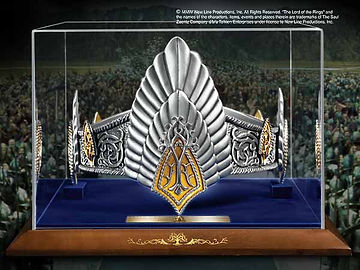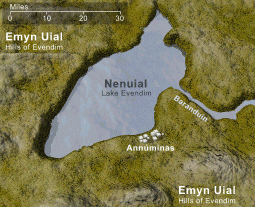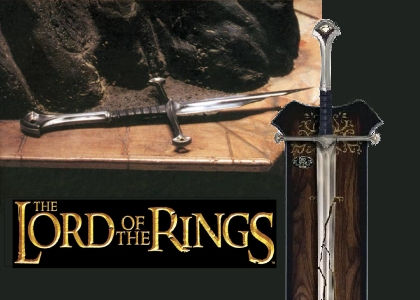The Realm of Gondor
"Et Eärello Endorenna utúlien.
Sinome maruvan ar Hildinyar tenn’ Ambar-metta!"
"Out of the Great Sea to Middle-earth I am come.
In this place will I abide, and my heirs, until the ending of the world!"

All who enter the Tower of the Guard, the Tower of Ecthellion, see the banners caught in the high breeze.
In the court of stone, a White Tree, it is dead. The Throne is without a King.
Heirlooms of Gondor
The Crown
Here is the Great Crown of King Eärnur, left in the Citadel after he road forth to confront the dreaded Witch-king of Angmar.

The Sceptre of Annuminas
Silver Rod, brought to Middle-earth by Elendil. It represented the chief mark of royalty in Arnor. After the end of the North-kingdom, it was in Elrond’s keeping in Rivendell until he returned it to Elessar, 34th King of Gondor on his wedding.

Narsil
Forged by Telchar, a great Dwarven Smith of Nogrod in the Ered Luin, the mighty sword of Elendil shattered in the Last Alliance of Elves in Men at the end of the Second Age. Isildur, took up the shards of the blade and severed the One Ring from Sauron’s Hand. After the battle, the Shards of Narsil were kept in Rivendell. On the eve of the War of the Ring, the sword was reforged as Anduril.

The Ring of Barahir
A Ring of the Noldor made in Valinor. Also know as the Ring of Felagund, it was given to Barahir after the Dagor Bragollach for saving Lord Finrod’s life as a pledge of aid in times of need. The Ring was one of the most highly revered heirlooms of the North-kingdom, for several times throughout history it was nearly lost. Beren, Dior, the Faithful of Númenor all preserved and passed on the ring. When Arthedain fell Arvedui gave it to the chief of the Lossoth for his aid. Later the Dúnedain ransomed the ring, where it remained in Rivendell. [Note: This is the ring that Aragorn wears throughout the Lord of the Rings Film on his left hand.]
Finrod to Barahir:
“This is a thing worth beyond your reckoning. For its ancestry alone. It has no power, save the esteem those hold it who love my house.”

Palantiri
The Seven Seeing-stones that were wrought by the Noldor and Eldamar given to the Faithful of Númenor. After the downfall, Elendil saved the stones and brought them to Middle-Earth. Each of the seven were kept at these locations: Osgiliath, Minas Ithil, Minas Anor, Orthanc, Annúminas, Amon Sûl, and Elostirion. Each of the stones were lost during the struggle against Sauron, except for a few. The Palantír of Osgiliath was lost when the city burned during the Kinstrife. It was the master stone, capable of seeing all the other six stones. The Palantíri of Annúminas and Amon Sûl were lost when King Arvedui’s ships sunk in the Sea in an attempt to escape the Witch-King. The Palantír of Minas Ithil was captured by the Nazgûl and Sauron used it in Barad-dûr and used it to influence the minds of the possessors of the Palantír of Orthanc (Saruman) and Palantír of Minas Anor[Tirith] (Denethor II) during the War of the Ring. These two stones were preserved, however none dare look at the Palantír of Minas Tirith for fear of seeing the burning hands and torment of Denethor. Elessar preserved and used the Palantír of Orthanc during his reign as High King of the Reunited Realm. The last stone, the Palantír of Elostirion was taken back into the keeping of the Eldar after the fall of Elendil. It remained at the Tower Hills west of the Shire, and ever looked at Valinor across the sea. This stone sailed into the West with the Passing of Keepers of the Rings.
Only the King and the ruling Steward of Gondor had the authority to use the stones. It has been surmised, that after the Ithil stone fell to Sauron, none of the ruling Stewards dared to use the Anor Stone, save one, Denethor II. Elessar used his authority as future king to take possession of the Palantír of Orthanc when Wormtongue cast it from the Tower of Orthanc. (A side note: The Tower of Orthanc was built by the Númenoreans and not by the Traitor Saruman)
